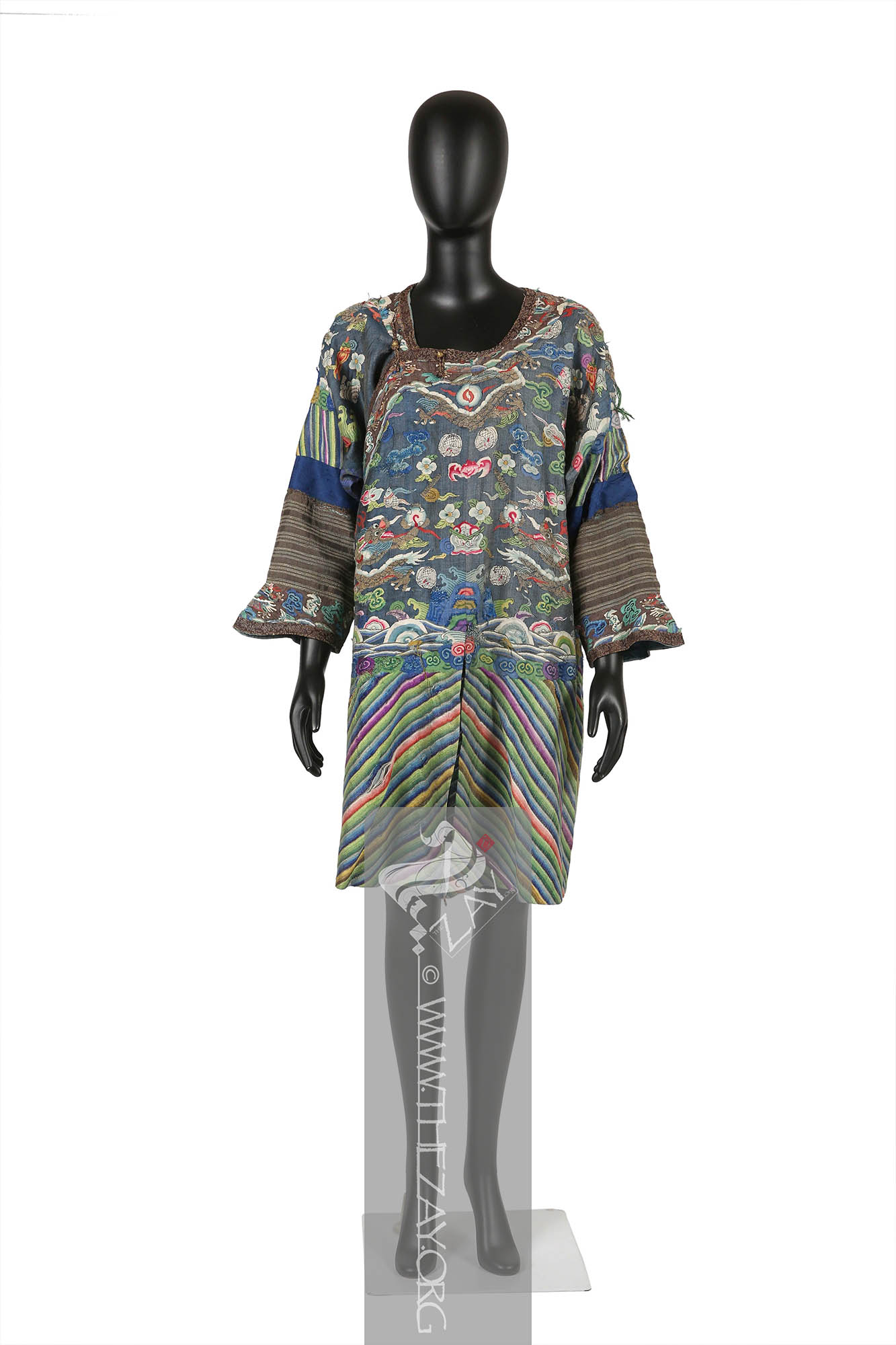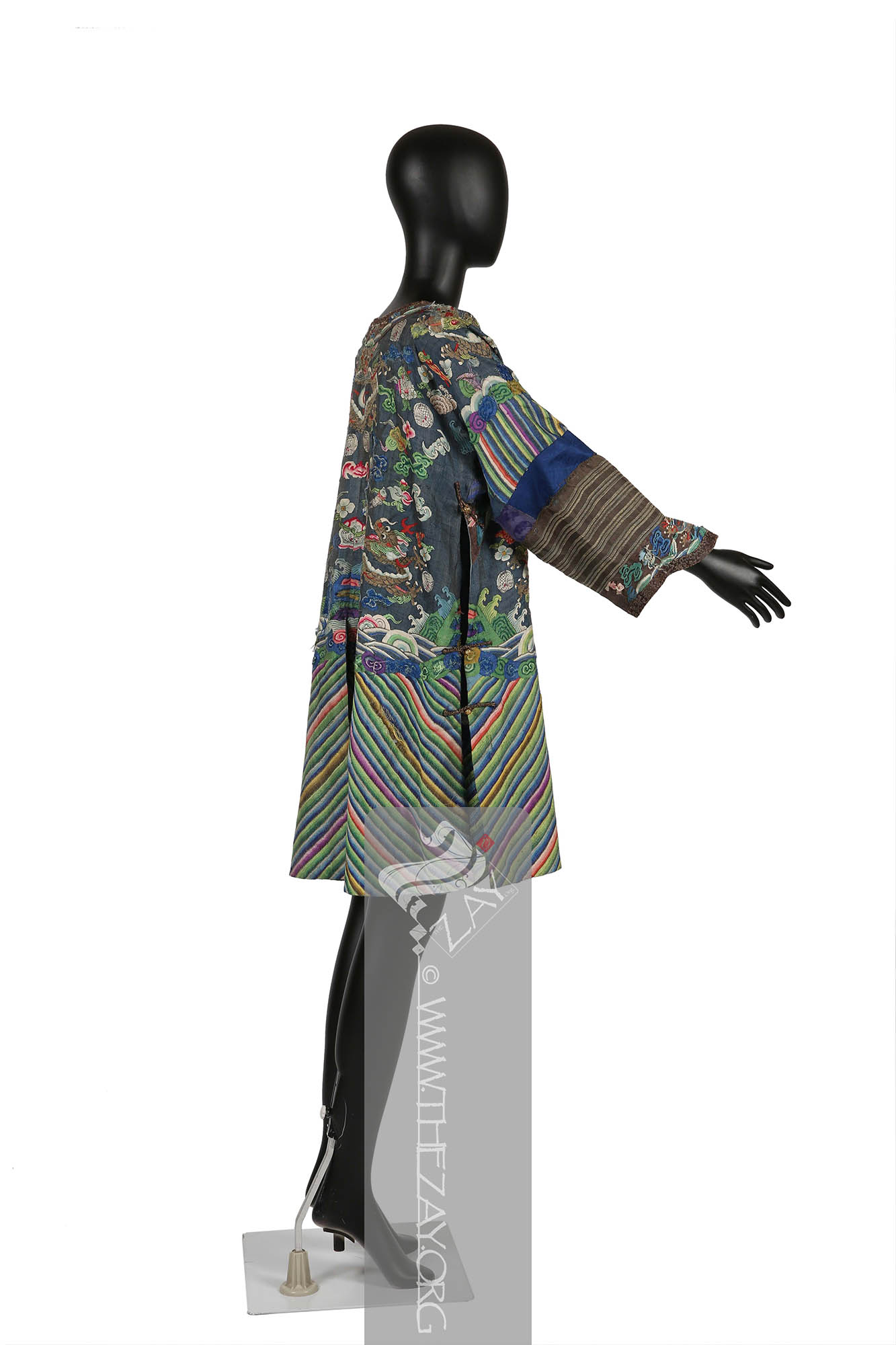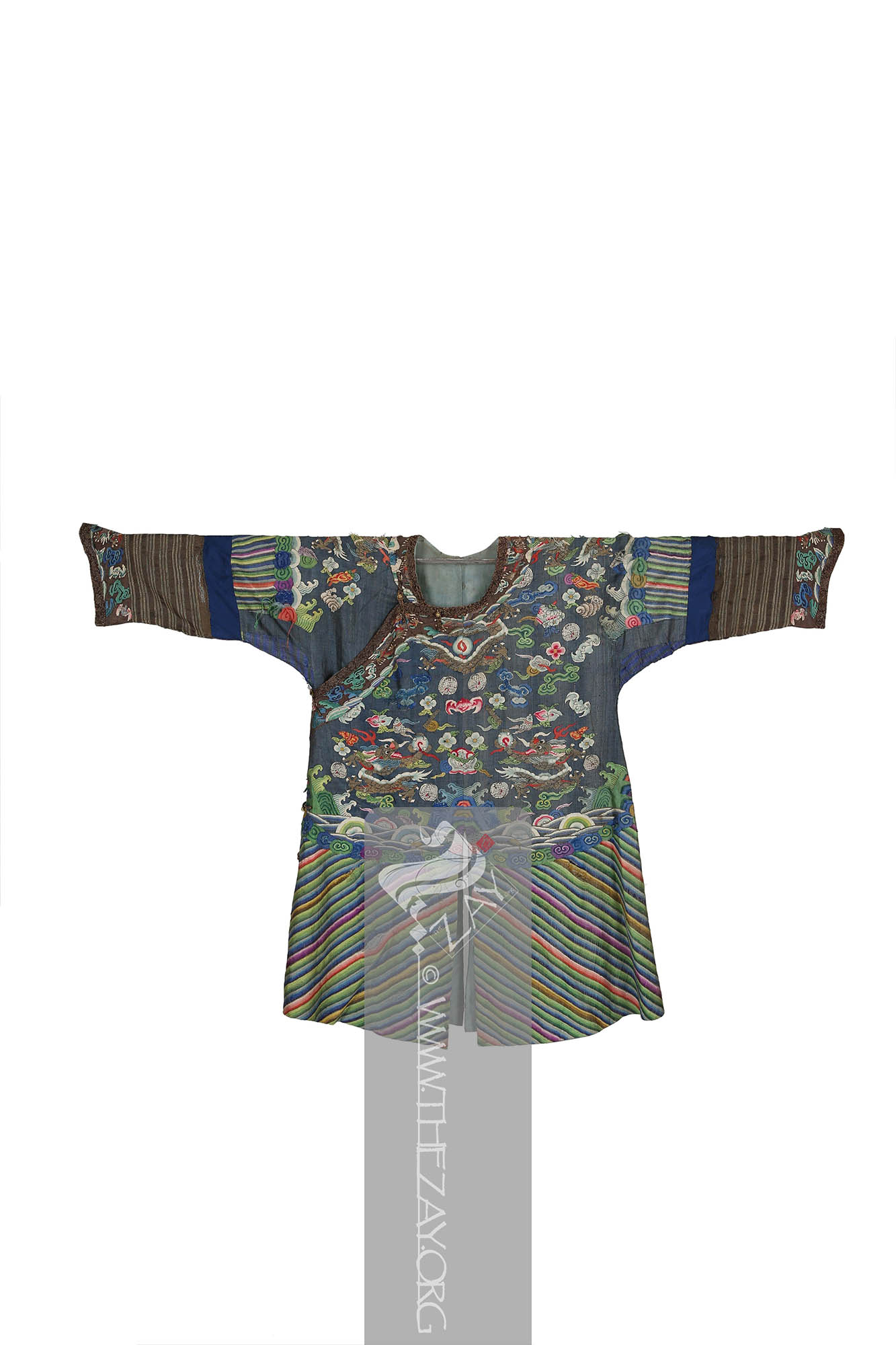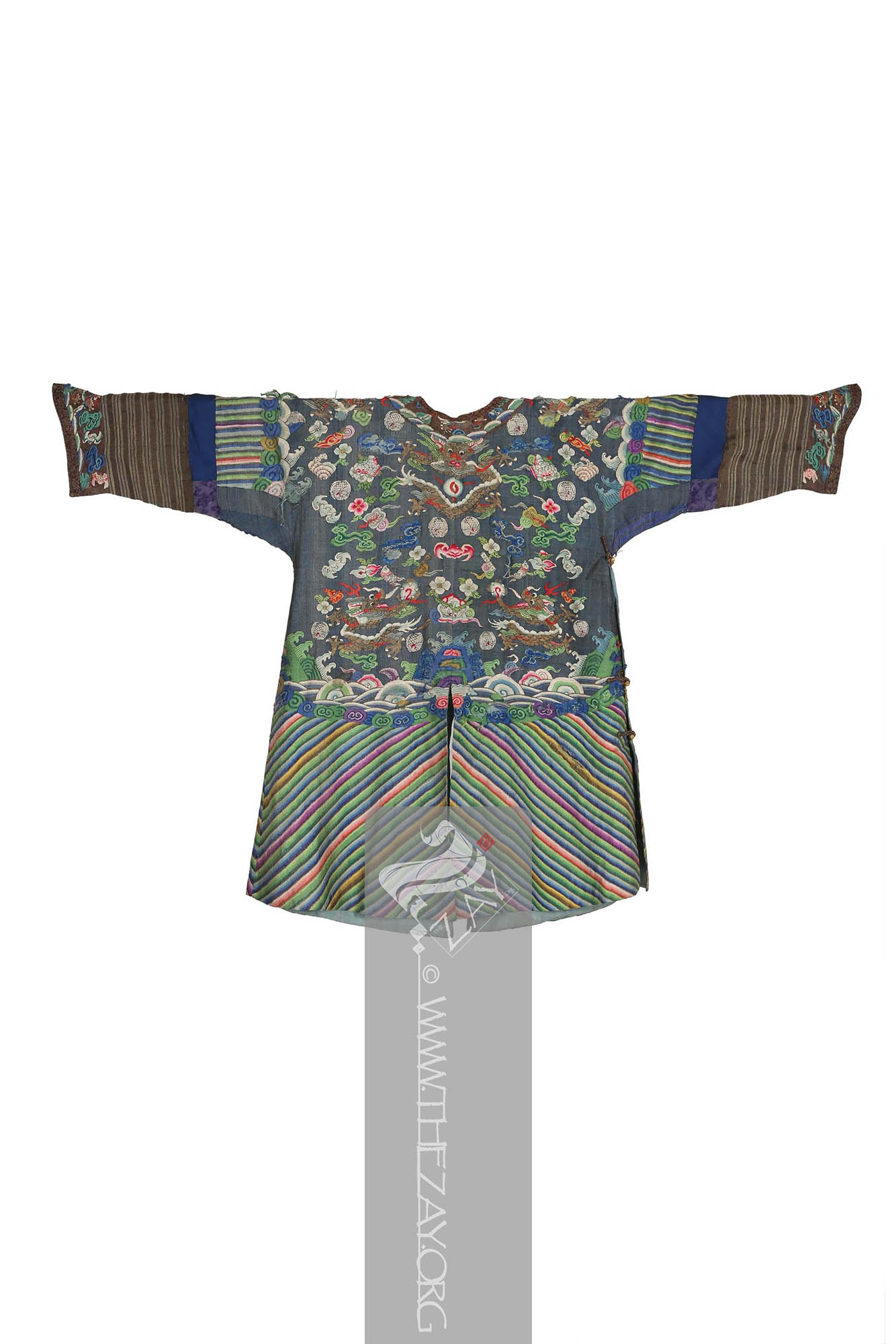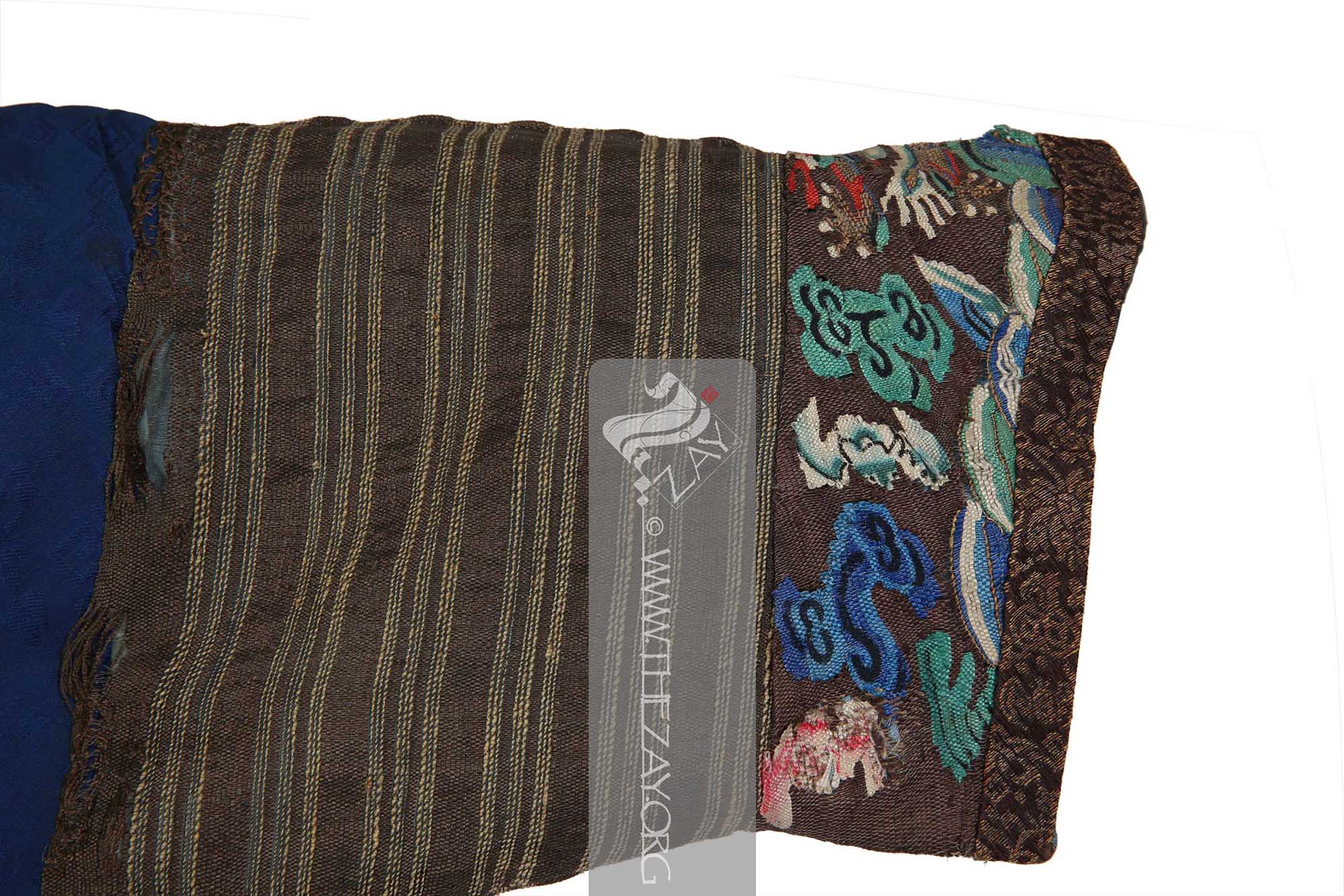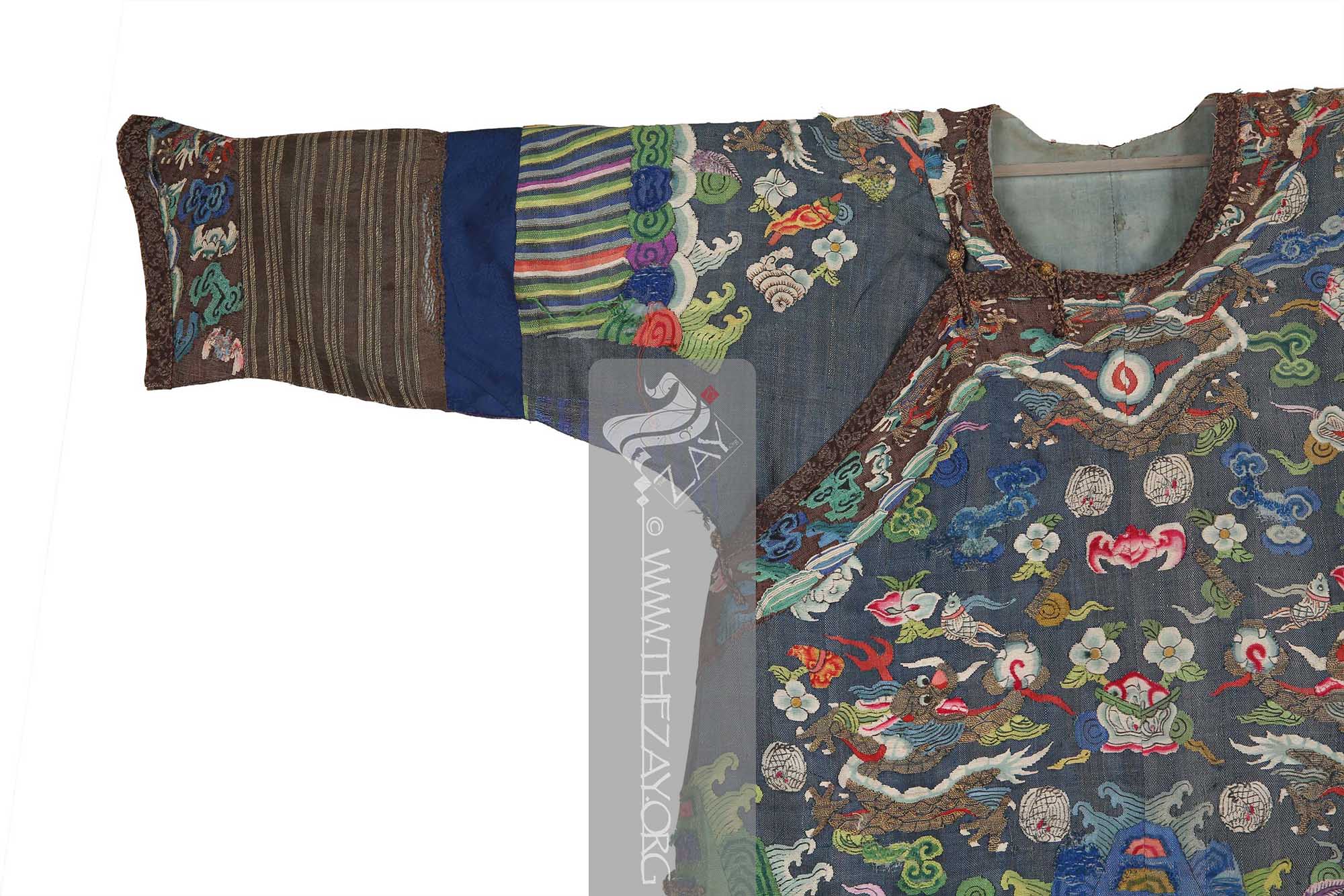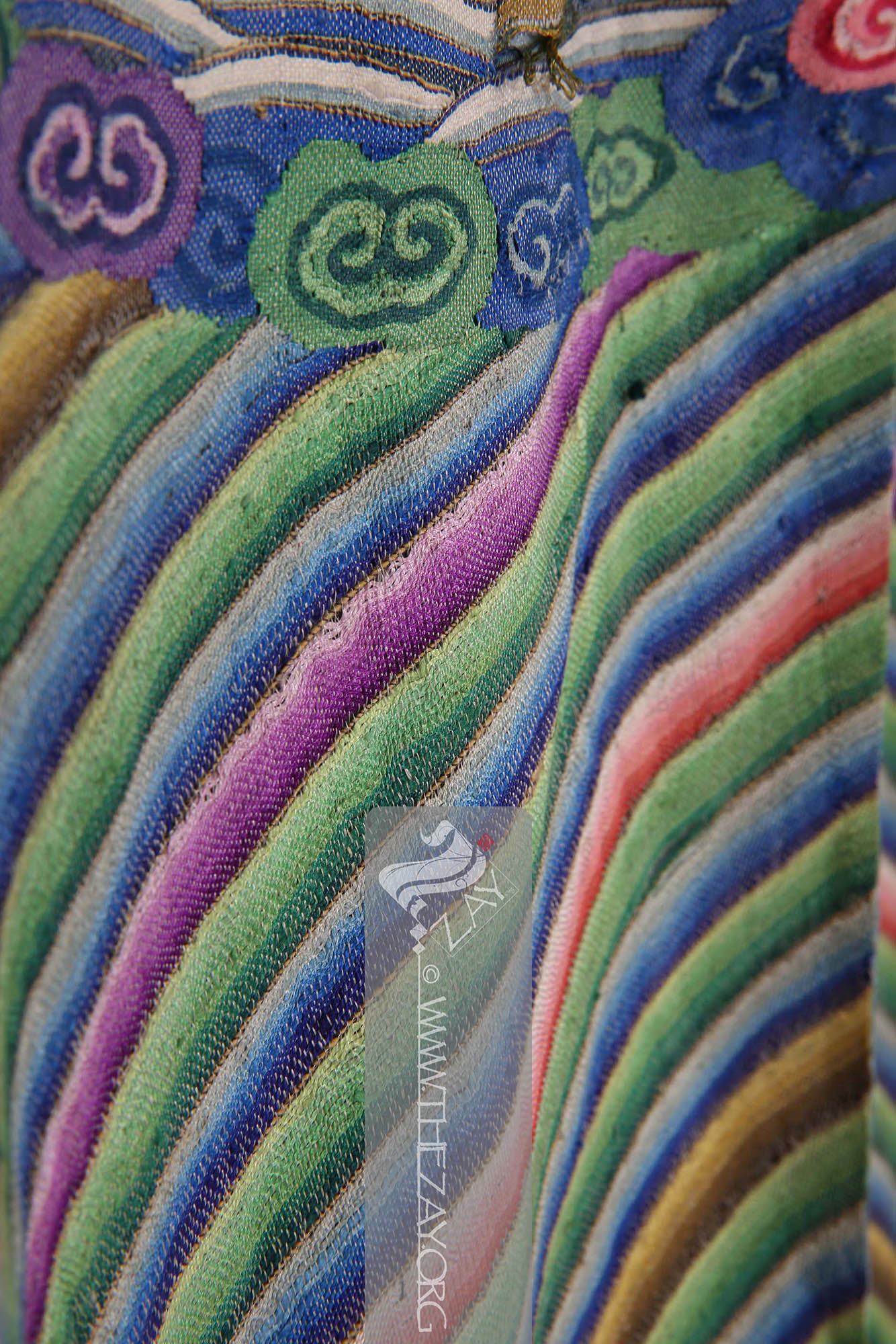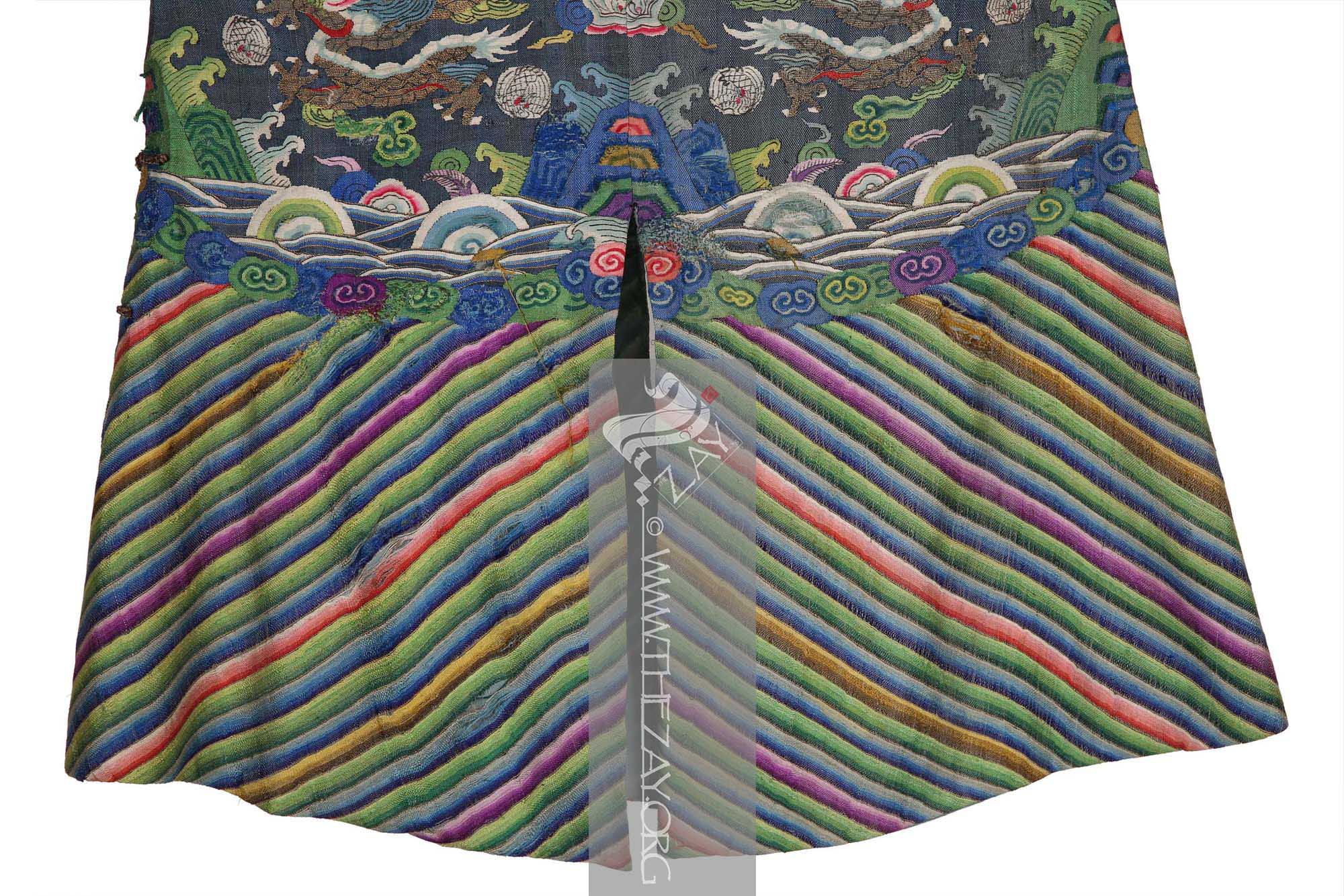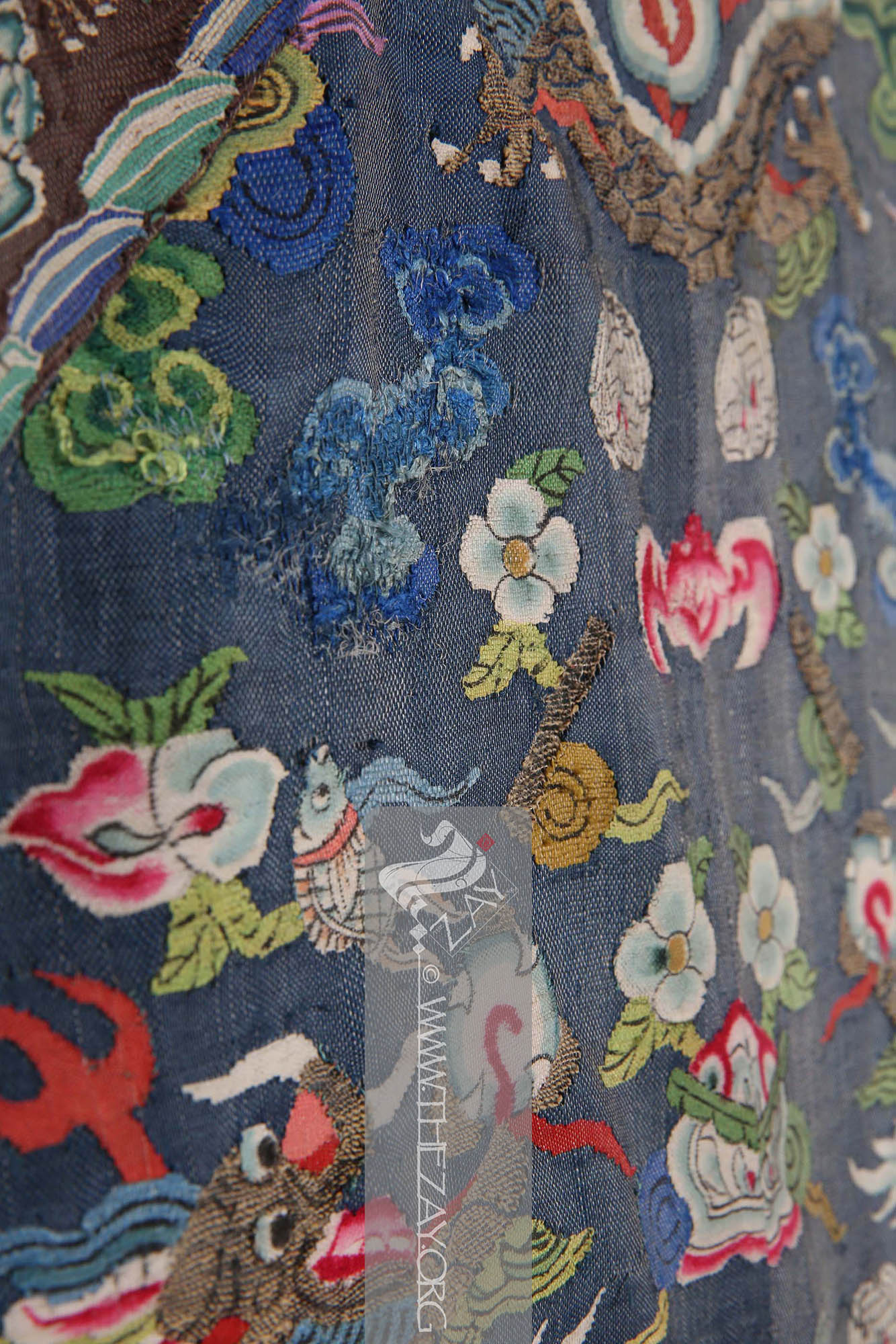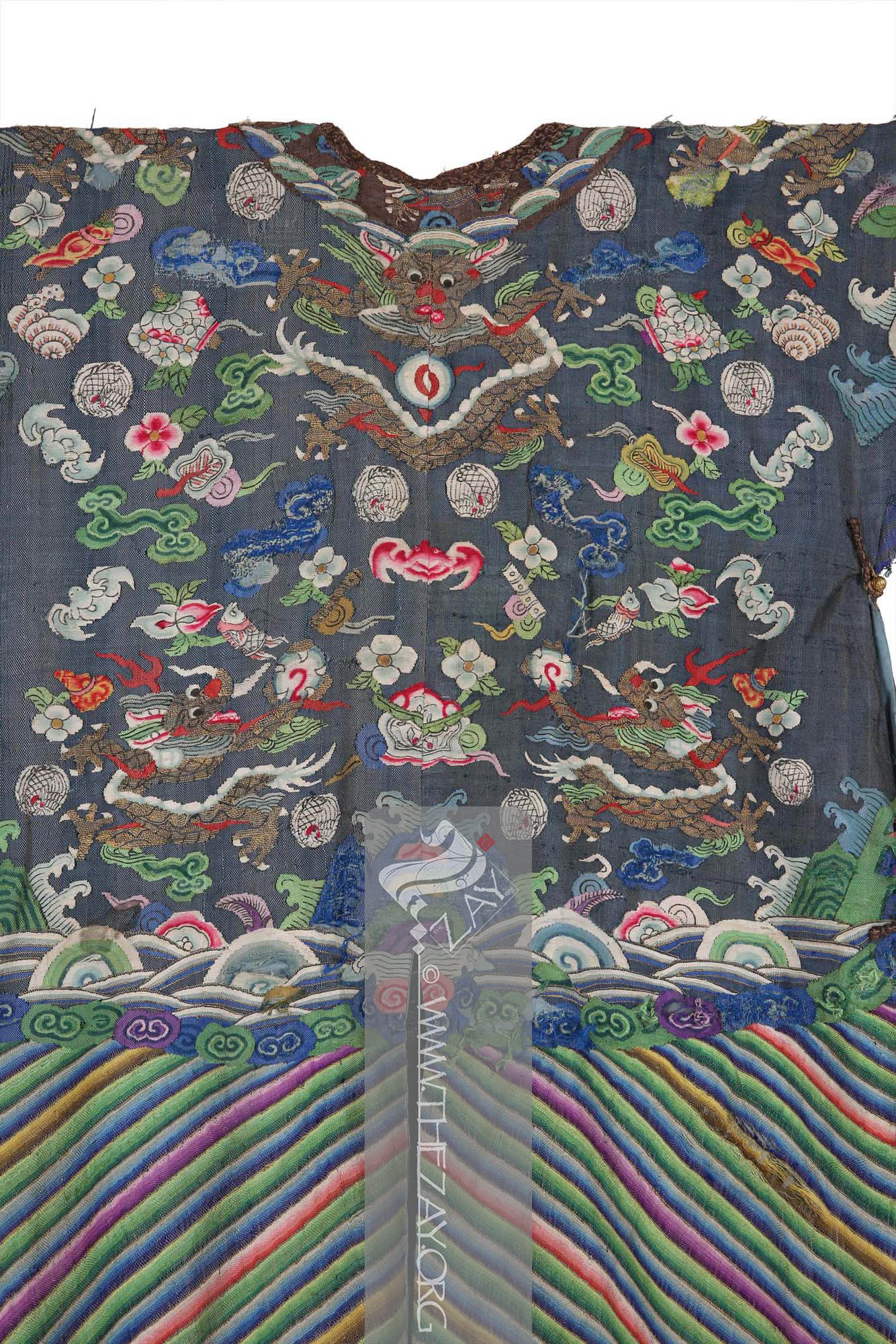Object HistoryThis child version woven blue silk Dragon robe was purchased from Kerry Taylor Auctions in 2015 by Dr. Reem El Mutwalli to enhance the
Zay
Zay: (Arabic: costume, Pl. azyaā’), a set of clothes in a style typical of a particular country or historical period. Initiative collection.
Object Features This blue silk (
jifu_mangpao
Jifu_mangpao: (Chinese jifu – Auspicious dress; mangpao – Python or four clawed dragon robe), were traditional semi formal Chinese court robes for festive occasions worn by both men and women during joyful celebrations. Characterised by their four clawed dragons and horse hoofed cuffs they were reserved for third ranking princes and below. ) or four-clawed dragon robe is primarily embroidered in colourful silk
floss
Floss: (Old French: flosche – nap of velvet), is a type of silk fibre obtained from the cocoons of wild silkworms. It is characterized by its long, fluffy fibers that are not tightly woven, making it ideal for use in various textile applications such as embroidery, lace-making, and sewing. threads on a silk base. There are also elements of different weaves attached to this.
The robe has a side opening with possibly gold or brass balls for buttons with (
frog_fastener
Frog_fastener: (Synonym: Chinese frog closure, frog closure), is a decorative and functional type of button used to fasten clothing. Said to have originated between c. 5th to 7th century China these buttons consist of a cord or braid looped through a decorative knot.
) loops. The collar, lapel, and sleeve hems are separately woven in copper threads and attached to the robe. The piece is primarily woven with floral motifs and animal figures symbolic of both Buddhist and Daoist philosophies.
The field of the robe is primarily woven flat like a
tapestry
Tapestry: wall hanging or other large piece of fabric that is woven in coloured weft
Weft: one of the two basic components used in weaving that transforms thread or yarns into a piece of fabric. It is the crosswise thread on a loom that is passed over and under the warp threads. threads or embroidered with a decorative design. Typically made of wool, but they can also be made of other materials such as silk, linen, or cotton. Often used to decorate homes, churches, and other buildings. or carpet in a range of colours. The top part covering the torso is embellished with a total of eight dragon figures with each dragon featuring a total of eight claws with four on each paw. Essentially the rank of the wearer was signified by the number of claws on each paw.
While only an emperor could wear a five-clawed dragon robe a four-clawed robe like this piece was worn by aristocrats or members of a high-ranking family. The body of one of the dragons in the front just below the neckline signifies the wearer as the eighth dragon. Each dragon is chasing a flaming pearl that signifies, wealth, good luck, and prosperity.
Interestingly this robe is also a stunning example of a (
kesi
Kesi: (Chinese: kesi – cut silk), a weaving technique in Chinese silk tapestry
Tapestry: wall hanging or other large piece of fabric that is woven in coloured weft
Weft: one of the two basic components used in weaving that transforms thread or yarns into a piece of fabric. It is the crosswise thread on a loom that is passed over and under the warp threads. threads or embroidered with a decorative design. Typically made of wool, but they can also be made of other materials such as silk, linen, or cotton. Often used to decorate homes, churches, and other buildings. using short length weft
Weft: one of the two basic components used in weaving that transforms thread or yarns into a piece of fabric. It is the crosswise thread on a loom that is passed over and under the warp threads. threads with each colour using a separate bobbin. The threads are tucked into the textile in such a way that only the weft
Weft: one of the two basic components used in weaving that transforms thread or yarns into a piece of fabric. It is the crosswise thread on a loom that is passed over and under the warp threads. threads are visible in the finished fabric. ) weave, where yarns are woven in such a way that it creates an illusion of cut threads or two different patches of fabric sewn together.
It also has motifs of flying bats that signify happiness. Additionally, it also features floral motifs, rolling clouds, and waves. From the waist down the robe features a broad section of (
lishui
Lishui: (Chinese: lishui – standing water) or (stripes), is a set of multicoloured diagonal lines either straight or wavy running parallel to each other forming a pattern that depicts calm sea waves. ) stripes signifying calm waters beyond the stormier ones above it. The waist is slit in halves both in front and at the back – a style adapted for ease of movement, especially during riding.
The sleeves are constructed of four different woven fabrics. The primary fabric of the piece is attached to a royal blue (
satin
Sātin: (Arabic: Zaytuni: from Chinese port of Zayton in Quanzhou province where it was exported from and acquired by Arab merchants), one of the three basic types of woven fabric with a glossy top surface and a dull back. Originated in China and was fundamentally woven in silk.) (
damask
Dāmāsk: (Arabic: Damascus – a city in Syria), is a luxurious fabric woven with reversible patterns typically in silk, wool, linen, or cotton. Originating in China, the fabric was perhaps introduced to European traders at Damascus – a major trading post on the Silk Road with a thriving local silk industry. ) piece and two brown pieces – one featuring rows of straight lines running parallel to each other, and the other featuring colourful patterns woven over a brown background. The lining of the robe is constructed of light blue silk of a thin
satin
Sātin: (Arabic: Zaytuni: from Chinese port of Zayton in Quanzhou province where it was exported from and acquired by Arab merchants), one of the three basic types of woven fabric with a glossy top surface and a dull back. Originated in China and was fundamentally woven in silk. weave.
Although identified as a child’s coat by the previous collector the measurement of the piece suggests otherwise.
With just a handful of countries earning mentions in the “Object range” section due to technical limitations, one must never forget the vast range of influence the Chinese culture has had across the globe, especially in South and central Asia, southeast Asia, and the Middle East. With its heavy influence on the cultures of Southeast Asia, especially its neighbouring nations, it would not be presumptuous of us to categorise all the countries of Southeast Asia under the same banner where objects like this are highly likely to be found.
Links 



